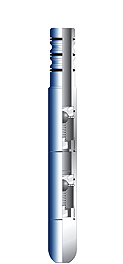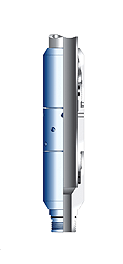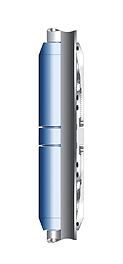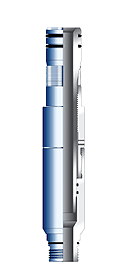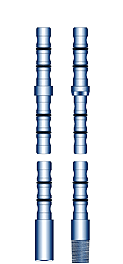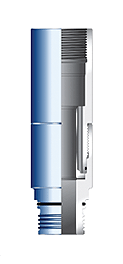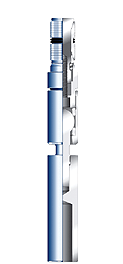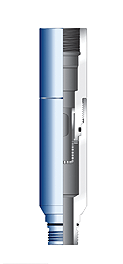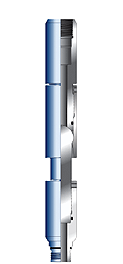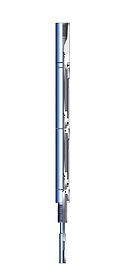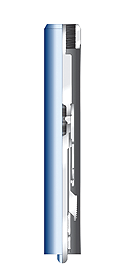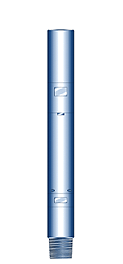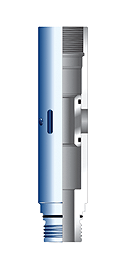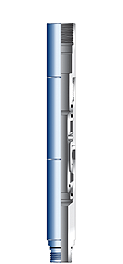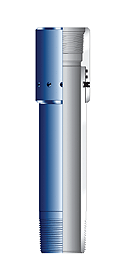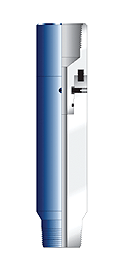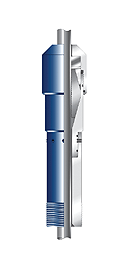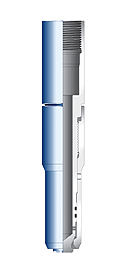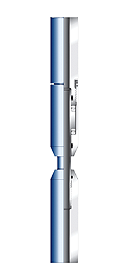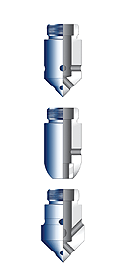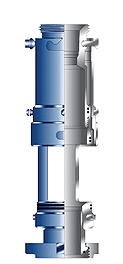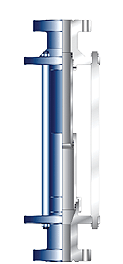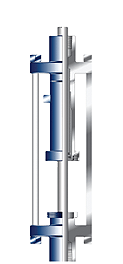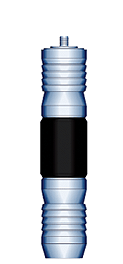Products - service tools
Carbide Mills
The Select Energy carries a large range of types and sizes of carbide mills. Such as Junk Mills, Wash-Overs, Burn Shoes, Tapered Mills, Flat Bottom, and Pineapple. Select will match the mill to the application to ensure a successful milling operation.
Downhole Drilling Motor
The Select Energy Downhole Drilling Motor incorporates state of the art bearing and power sections. These Motors are inspected pre/post all jobs to insure they are in top shape for any usage.
GS Pulling and Releasing Tool
The GS Pulling and Releasing Tool is an effective means of engaging, locating and pulling on standard, internal fishing necks. The GS Tool consists of a colleted latching system that allows for maximum pull providing a high shear release on tools, or the ability to over pull any tool that may be lodge into the well bore. It’s thru bore allows circulation during deployment.
High Load Grapple Connector
The Select High Load Grapple Connector is a surface hang-off tool used to hang high coiled tubing string loads from the bottom of a tubing hanger. For example, the 2” High Load Grapple Connector has been designed to hold over 60,000# (28,000 daN) and handle pressures of 5,000 psi (35 mpa).
Motorhead Assembly
The Select Energy Motorhead Assembly is a compact tool with a multitude of features. Included are dual flapper check valves, circulating sub, and ball activated disconnects. The motorhead is a tool that can be run in conjunction with either Coiled Tubing (with dimple grapple as shown) or on Jointed Tubing.
Thermal Grapple Connector
The Thermal Grapple Connector is a tool used for connecting Coiled Tubing to either surface or sub-surface equipment in high temperature environments. Using Graph-Oil packing the Thermal Grapple can withstand temperatures of 400°f.
Low Restriction Check Valve
The Low Restriction Check Valve is typically run on the bottom of the coiled tubing for completion or workover operations. The Check Valve is designed with a large cross-sectional area above the ball and seat for maximum flow. It can be stacked for applications that require redundant sealing performance.
Flapper Check Valve
The Flapper Check Valve is connected to the coiled tubing to eliminate flow back of fluids or gas through the tubing string. The spring loaded flapper valve provides maximum flow area, while providing high performance sealing capability. The Flapper Check Valve is frequently run on drilling motor tool strings for workover and completion operations. The Flapper Check Valve provides safe operation when running coiled tubing into high-volume, high-pressure, or H2S environments.
Surface Isolation Plug (SIP)
Select Energy Systems developed the Surface Isolation Plug to meet industry demand for a method to isolate wellbore pressure inside the coiled tubing pressure, prior to retrieval from the well. The Hydraulic Setting Tool allows the operator to lubricate in and set the SIP in the tubing at surface, shutting off well bore pressure. The Surface Isolation Plug is positioned in the coiled tubing bore to allow room for a Roll-On Connector to be installed above the plug.
(SIP) Installation Tool
The Surface Isolation Plug Installation Tool is a hydraulically activated tool used to install isolation plugs in live coiled tubing strings. The plug is connected to the end of the piston shaft and run into the well, where it is set at a predetermined point near the top of coiled tubing string.
Dimple-Grapple Connector
The Dimple-Grapple Connector is an external type of connector, providing the simplicity of a grapple connector and the torque capabilities of a dimple connector. The connector is non-rotational and highly recommended when using equipment that produces torque. The Dimple-Grapple Connector can be used with downhole drilling motors, hammer mills, and any other type of hammering or jarring equipment. The coiled tubing must first be prepared for the dimple connector prior to installation by using a Dimple Connector Assembly Tool.
Dimple Connector
The Dimple Connector is a non-rotational connector used to join completion tools and workover equipment to the end of the coiled tubing. The connector is highly recommended when using tools that produce torque such as downhole motors, hammer mills, and other equipment of this type. The Dimple Connector is also used to connect nipples, packers, shear subs and other completion equipment to the coiled tubing. The coiled tubing must be prepared for the dimple connector prior to installation by using a Dimple Connector Assembly Tool.
Dimple Connector Assembly Tool
The Dimple Connector Assembly Tool is used to prepare the coiled tubing before the Dimple Connector or Dimple-Grapple Connector is installed onto the coiled tubing. The heavy-duty design uses large-socket head cap screws with rounded heads to indent the coiled tubing.
Grapple x Grapple Connector
The Grapple x Grapple Connector is used to join two strings of coiled tubing. This connector is designed for use in cases where the spool cannot take all of the coiled tubing required for a hang-off or workover and additional coiled tubing is needed.
Internal Grapple Connector
The Internal Grapple Connector is an internal connector used to connect slimline bottom hole assemblies and tools to the coiled tubing. It provides an easier method of connecting BHA’s to the coiled tubing with a slightly larger bore than a Roll-On Connector. The Internal Grapple Connector can also be used to connect or join two strings of coiled tubing, eliminating the need for welding.
Roll-On Connector
The Coiled Tubing Roll-On Connector connects two tubing strings and is designed to prevent breakage when cycling the coiled tubing over the gooseneck on the coiled tubing unit. Installation begins by removing the weld bead and burrs from the end of the coiled tubing then inserting the Roll-On connector through the end. An installation tool is used to crimp the coiled tubing over the connector, and a hardened roller wheel on the installation tool crimps the coiled tubing into the connector grooves.
Cable Clamp Assembly
The Coiled Tubing Cable Clamp Assembly is used below a Dimple Connector or Dimple-Grapple Connector when the operator has wireline inside the coiled tubing. The Cable Clamp Assembly allows the operator to run a more conventional workover without having to remove the wireline. The assembly secures the wireline safely to the side of the coiled tubing to allow pumping of fluids or dropping disconnect balls.
Snake Pin Assembly
The Snake Pin Assembly is connected to the coiled tubing and used to stab the coiled tubing into the injector, or for loading a drop spool string into the injector. One end of the Snake Pin Assembly is tapered, and the other end is connected to the coiled tubing with a swivel joint, and a flexible cable. Larger sizes incorporate a knuckle joint to reduce stress when the snake pin assembly passes over the gooseneck on the top of the injector.
Debris Filter
The Debris Filter is designed to be run in conjunction with coiled tubing tools, such as jetting nozzles, fluid control valves or ball-check valves that are sensitive to small particulate material. The filter contains a metal screen, with either slots or holes, depending on the filtering capacity required.
Knuckle Joint
The Knuckle Joint allows flexibility in the tool string for fishing operations and completion work on vertical, deviated or horizontal wells. The knuckle joint is designed for full-fluid passage for operation of tools below it, such as wash tools or fishing equipment. The tool is of a heavy-duty design and uses a primary metal to metal seal, combined with a secondary O-ring seal. Threaded connections allow the knuckle joint to be placed at the required point in the coiled tubing BHA.
Splined Knuckle Joint
The Splined Knuckle Joint offers the same functionality of the standard knuckle joint with the added feature of transmitting torque. The torque feature is ideal for bottom hole assemblies that will be using a motor, while retaining the flexibility in the tool string for fishing operations, and for completion work on vertical, deviated or horizontal wells.
Hydraulic Setting Tool
The Hydraulic Setting Tool is a pressure-activated setting tool used to set wireline retrievable plugs, permanent packers, bridge plugs, cement retainers or other types of completion equipment. The setting tool is connected to the end of the coiled tubing and run to depth. Pressuring up the tubing string activates the hydraulic pistons. The force multiplies as the pressure passes through each piston stage, providing the needed force to set the downhole equipment.
Hydraulic Setting Tool Adapter
The Hydraulic Setting Tool Adapter is run with a wireline or Hydraulic Setting Tool and provides a quick and easy method of connecting permanent or retrievable packers to the setting tool.
Pneumatic Hammer
The Pneumatic Hammer delivers downward impact when forces greater than tubing weight is required. This is beneficial when retrieving bridge plugs or other tools requiring downward force to release. The hammer can be powered with air, nitrogen or foam. The Pneumatic Hammer uses low volumes and pressures; thus it is well-suited for use with coiled tubing units outfitted with self-contained-compressors.
Circulating Port Sub
The Circulating Port Sub provides the ability to circulate above a stuck or plugged tool string. The Port Sub is equipped with rupture plugs that are activated by pumping a ball down the coiled tubing. Once the ball is on seat, an increase in pump pressure will cause the plug to rupture at the predetermined pressure, allowing circulation. The Circulating Port Sub is used with bottom hole assemblies in open hole completions or workovers utilizing downhole motors or other types of equipment.
Hydraulic Release Sub
The Coiled Tubing Hydraulic Release Sub provides a surface controlled method of releasing the coiled tubing from the tool string. It is a ball-operated Release Sub with latching lugs and splined torque lugs, specifically designed for use with rotating wash tools or other applications that transmit torque.
Rotational Safety Shear Sub
The Rotational Safety Shear Sub is used above bottom hole assemblies which, in operation, must rotate independently of the coiled tubing. The two-piece unit uses shear screws to hold a preset force value, determined by type, quantity and shear rating of the screws.
Non Rotating Safety Shear Sub
The Select Non-Rotating Safety Shear Sub was developed for use with stationary downhole equipment that develops rotational torque. The shear sub is installed in the tool string between the coiled tubing and the downhole tool. An example would be an ESP (electric submersible pump), run on small diameter coil, or polyethylene tubing, which upon startup, if allowed to rotate, would cause twisting and subsequent failure of the power cable.
Run Through Shear Sub
The Coiled Tubing Run Through Shear Sub has a standard safety shear and fish neck for use above a tension set packer. The bidirectional slip and seal set, above the shear mechanism, locks the shear sub and packer to the coiled tubing at any point. With this system, the tension packer, equipped with the Shear Sub is retained in the lubricator tube while the desired length of coiled tubing is run through the packer into the wellbore.
Adjustable Wash Tool
The Adjustable Wash Tool is run on the bottom of the coiled tubing string. The Wash Tool has a threaded connection and can be run with a variety of connections, check valves or other equipment. The tool can be adjusted to many different spray configurations for depth washing, de-scaling, perforation clean up, chemical washes or debris clean-out. By simply turning the adjustable body, the cleaning fluids can be directed in a fanning method or angled as required; thus, there is no need to have multiple nozzles in inventory.
Rotating Wash Tool
The Coiled Tubing Rotating Wash Tool is connected to the bottom of the coiled tubing and works as a jetting tool. The wash tool is designed so that fluid or pressure passes through the tool and out of the wash nozzle. The configuration of the jetting ports, combined with the pressure, rotates the nozzle. This rotating action has proven to be very successful when performing horizontal clean-outs, de-scaling casing or tubing, chemical washes on the perforations, and tubing cutting.
Wash Nozzles
The Wash Nozzle is located at the bottom of the coiled tubing and has a threaded connection so it can be run with connectors, check valves or other equipment. There are many configurations with different hole sizes and angles depending on the application.
Lantern Work Window
The Lantern Style, J-Slot Work Window is a service tool used on the wellhead during shallow well, coiled tubing completions. This tool provides an access point where the coiled tubing can be exposed to install landing equipment without disconnecting coiled tubing service equipment.
Hydraulic Work Window
The Hydraulic Style Work Window is installed above the coiled tubing quad BOP or Coiled Tubing Hanger pack-off element and ensures safe coiled tubing hang-off and other coiled tubing operational procedures. After the coiled tubing is landed at the desired depth, the annulus pressure is controlled with the quad BOP or pack-off element on the Coiled Tubing Hanger.
Threaded Work Window
The Threaded Style Work Window is installed above the coiled tubing quad BOP or hanger pack-off element and ensures safe coiled tubing hang-offs or other operations. After the coiled tubing is landed at the desired depth, the annulus pressure is controlled with the quad BOP or pack-off element on the hanger.
Casing Scraper
The Select Casing Scraper is used to remove foreign matter on the inside casing wall (of casing or tubing) in order to provide a smooth clean casing I.D. for running sub-surface equipment (such as packers). The Casing Scraper features a one piece body with full 360o casing I.D. cover-age provided by six spring loaded Scraper Blades. The design also features a large bypass area around and between the blades for ease of circulating.
Permanent Bridge Plug
The Bridge Plug is an economical, fully drillable plug for applications where a 35 MPa (5,000 psi) plug is sufficient. The Bridge Plug is suitable for well abandonments or zone suspensions. It is designed for running and setting with an E-4 E-Line setting tool, or on regular coiled tubing, using a hydraulic setting tool.







